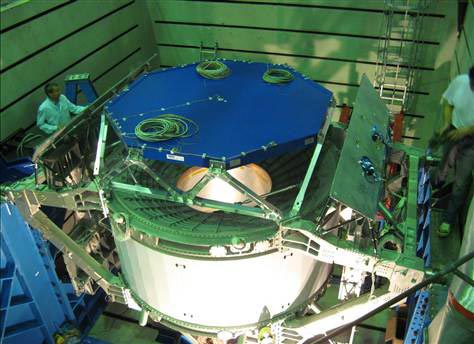
An instrument for detecting cosmic rays – and possibly even dark matter – has finally been lifted into orbit on board the Space Shuttle Endeavour. The Alpha Magnetic Spectrometer (AMS), which is the brainchild of the Nobel-prize-winning physicist Samuel Ting, will soon be installed on the International Space Station (ISS). Ting first came up with the idea for the AMS in the 1990s but a series of setbacks, including the Columbia shuttle disaster in 2003, has led to the mission being continually delayed.
The launch of the AMS also marks the end of an era in space exploration, as this is the final mission of NASA’s Space Shuttle programme – which began with the launch of Columbia in April 1981. The lift-off from Kennedy Space Center in Florida involved celebrations commemorating the 30-year Space Shuttle programme.
Costing $2bn and weighing seven tonnes, the AMS detector uses a 0.15 T cylindrical magnet 1 m in diameter and 1 m in height to sort incoming particles according to their momentum and charge. The direction of bend of the particle tracks through the magnet’s bore depends on whether the particles are matter or antimatter, while the gradient of the bend is determined by their speed. This will allow the detector to distinguish between vast numbers of different types of cosmic-ray particle.
Searching for dark matter
Physicists are particularly interested in high-energy positrons (anti-electrons), which could be produced by collisions of dark-matter particles in the Milky Way. However, the ability of the experiment to detect dark matter is controversial. The magnet inside the detector was supposed to be an 0.87 T superconducting device, which the project’s scientists had spent nearly a decade designing and building. But in 2010 the researchers suddenly decided to revert to the weaker permanent magnet that had been flown on a test flight aboard the Space Shuttle in 1998.
The change was made in response to the decision to extend the lifetime of the ISS to 2020 and perhaps beyond. The superconducting magnet would only have had a three-year supply of liquid-helium coolant, leaving the AMS inoperative for most of the ISS’s lifetime. In addition, tests of the AMS at CERN in early 2010 revealed that the detector heated up more than expected – which would have reduced the time that the helium held out.
Some critics claim that the new configuration will make the experiment less likely to make discoveries such as the detection of dark matter, while others insist that the changes made at such a late stage could make failure more likely.
Seeking strangelets
The AMS could also detect strangelets, which are ultra-dense clumps comprising large numbers of up, down and strange quarks. This new form of matter was first proposed in 1984 by Edward Witten, but has yet to be seen by a succession of experiments. Strangelets could be produced when high-energy cosmic rays strike Earth’s atmosphere. The particles are expected to have a very high mass-to-charge ratio, which means that they should take a nearly straight path through the AMS.
AMS uses a series of silicon sheets positioned one on top of the other across the magnet’s bore to sense the position of particles as they travel through the magnet. To optimize for the replacement magnet as much as possible, the AMS team has shifted two of these planes so that they now lie well outside the magnet’s bore. The AMS researchers claim that the momentum resolution of the new configuration will be within 10% of that possible with the superconducting device.
The team also says that the extended running time of the experiment will allow it to gather about six times more data and boosts its chances of seeing rare cosmic-ray events. In addition, the mission could extend over an entire solar cycle, allowing it to study the effect of the Sun on cosmic-ray fluxes.



